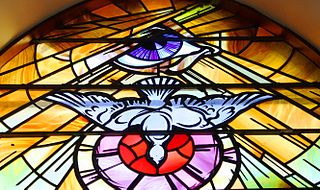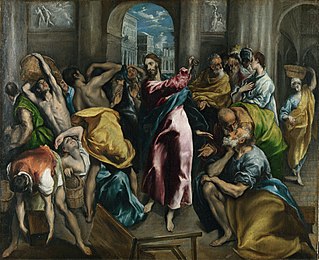Related Research Articles
Panentheism is the belief that the divine intersects every part of the universe and also extends beyond space and time. The term was coined by the German philosopher Karl Krause in 1828 to distinguish the ideas of Georg Wilhelm Friedrich Hegel (1770–1831) and Friedrich Wilhelm Joseph Schelling (1775–1854) about the relation of God and the universe from the supposed pantheism of Baruch Spinoza, after reviewing Hindu scriptures. Unlike pantheism, which holds that the divine and the universe are identical, panentheism maintains an ontological distinction between the divine and the non-divine and the significance of both.

Omnipresence or ubiquity is the property of being present anywhere and everywhere. The term omnipresence is most often used in a religious context as an attribute of a deity or supreme being, while the term ubiquity is generally used to describe something "existing or being everywhere at the same time, constantly encountered, widespread, common". Ubiquitous can also be used as a synonym for words like worldwide, universal, global, pervasive, all over the place.
The doctrine or theory of immanence holds that the divine encompasses or is manifested in the material world. It is held by some philosophical and metaphysical theories of divine presence. Immanence is usually applied in monotheistic, pantheistic, pandeistic, or panentheistic faiths to suggest that the spiritual world permeates the mundane. It is often contrasted with theories of transcendence, in which the divine is seen to be outside the material world.

Academic study of Jewish mysticism, especially since Gershom Scholem's Major Trends in Jewish Mysticism (1941), distinguishes between different forms of mysticism across different eras of Jewish history. Of these, Kabbalah, which emerged in 12th-century Europe, is the most well known, but not the only typologic form, or the earliest to emerge. Among previous forms were Merkabah mysticism, and Ashkenazi Hasidim around the time of Kabbalistic emergence.
The God gene hypothesis proposes that human spirituality is influenced by heredity and that a specific gene, called vesicular monoamine transporter 2 (VMAT2), predisposes humans towards spiritual or mystic experiences. The idea has been proposed by geneticist Dean Hamer in the 2004 book called The God Gene: How Faith is Hardwired into our Genes.
In philosophy, transcendence is the basic ground concept from the word's literal meaning, of climbing or going beyond, albeit with varying connotations in its different historical and cultural stages. It includes philosophies, systems, and approaches that describe the fundamental structures of being, not as an ontology, but as the framework of emergence and validation of knowledge of being. "Transcendental" is a word derived from the scholastic, designating the extra-categorical attributes of beings.

The attributes of God are specific characteristics of God discussed in Christian theology. Christians are not monolithic in their understanding of God's attributes.
In religion, transcendence is the aspect of a deity's nature and power that is completely independent of the material universe, beyond all known physical laws. This is contrasted with immanence, where a god is said to be fully present in the physical world and thus accessible to creatures in various ways. In religious experience, transcendence is a state of being that has overcome the limitations of physical existence, and by some definitions, has also become independent of it. This is typically manifested in prayer, rituals, meditation, psychedelics and paranormal "visions".
Plane of immanence is a founding concept in the metaphysics or ontology of French philosopher Gilles Deleuze.

The Baháʼí conception of God is essentially monotheistic. God is the imperishable, uncreated being who is the source of all existence. He is described as "a personal God, unknowable, inaccessible, the source of all Revelation, eternal, omniscient, omnipresent and almighty". Though transcendent and inaccessible directly, his image is reflected in his creation. The purpose of creation is for the created to have the capacity to know and love its creator. God communicates his will and purpose to humanity through intermediaries, known as Manifestations of God, who are the prophets and messengers that have founded religions from prehistoric times up to the present day.
Lurianic Kabbalah is a school of kabbalah named after Isaac Luria (1534–1572), the Jewish rabbi who developed it. Lurianic Kabbalah gave a seminal new account of Kabbalistic thought that its followers synthesised with, and read into, the earlier Kabbalah of the Zohar that had disseminated in Medieval circles.
Thomas Jonathan Jackson Altizer was an American university professor, religious scholar, and theologian, noted for his incorporation of Death of God theology and Hegelian dialectical philosophy into his body of work. He regarded his philosophical theology as also being grounded in the works of William Blake and considered his theology to have come into its own with his extended study of Blake's radical visionary thinking: The New Apocalypse: The Radical Christian Vision of William Blake (1967); indeed he regarded himself as the first and only fully Blakean theologian.

Wiccan views of divinity are generally theistic, and revolve around a Goddess and a Horned God, thereby being generally dualistic. In traditional Wicca, as expressed in the writings of Gerald Gardner and Doreen Valiente, the emphasis is on the theme of divine gender polarity, and the God and Goddess are regarded as equal and opposite divine cosmic forces. In some newer forms of Wicca, such as feminist or Dianic Wicca, the Goddess is given primacy or even exclusivity. In some forms of traditional witchcraft that share a similar duotheistic theology, the Horned God is given precedence over the Goddess.
Ohr is a central Kabbalistic term in the Jewish mystical tradition. The analogy of physical light is used as a way of describing metaphysical Divine emanations. Shefa is sometimes alternatively used in Kabbalah, a term also used in Medieval Jewish philosophy to mean Divine influence, while the Kabbalists favour Ohr because its numerical value equals Raz ("mystery"). It is one of the two main metaphors in Kabbalah for understanding Divinity, along with the other metaphor of the human soul-body relationship for the Sephirot. The metaphorical description of spiritual Divine creative-flow, using the term for physical "light" perceived with the eye, arises from analogous similarities. These include the intangible physicality of light, the delight it inspires and the illumination it gives, its apparently immediate transmission and constant connection with its source. Light can be veiled and reflected. White light divides into seven colours, yet this plurality unites from one source. Divine light divides into the seven emotional Sephirot, but there is no plurality in the Divine essence. The term Ohr in Kabbalah is contrasted with Ma'ohr, the "luminary", and Kli, the spiritual "vessel" for the light.
Divine presence, presence of God, Inner God, or simply presence is a concept in religion, spirituality, and theology that deals with the ability of God to be "present" with human beings.

Christ Driving the Money Changers from the Temple is a 1595-1600 Christian art painting by El Greco, now in the Frick Collection. It depicts the Cleansing of the Temple, an event in the Life of Christ.

Christ Driving the Money Changers from the Temple is a 1600 painting by El Greco, now in the National Gallery in London, England. It depicts the Cleansing of the Temple, an event in the Life of Christ.

Christ Driving the Money Changers from the Temple is a 1609 Christian art painting by El Greco, now in the church of San Ginés in Madrid. It depicts the Cleansing of the Temple, an event in the Life of Christ.

Christ Driving the Money Changers from the Temple is a 1571 Christian art painting by El Greco, now in the Minneapolis Institute of Art. It depicts the Cleansing of the Temple, an event in the Life of Christ.
Self-transcendence is a personality trait that involves the expansion of personal boundaries, including, potentially, experiencing spiritual ideas such as considering oneself an integral part of the universe. Several psychologists, including Viktor Frankl, Abraham Maslow, Pamela G. Reed, C. Robert Cloninger, Lars Tornstam, and Scott Barry Kaufman have made contributions to the theory of self-transcendence.